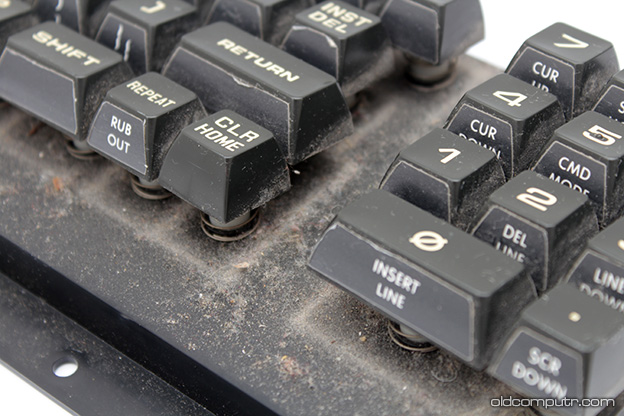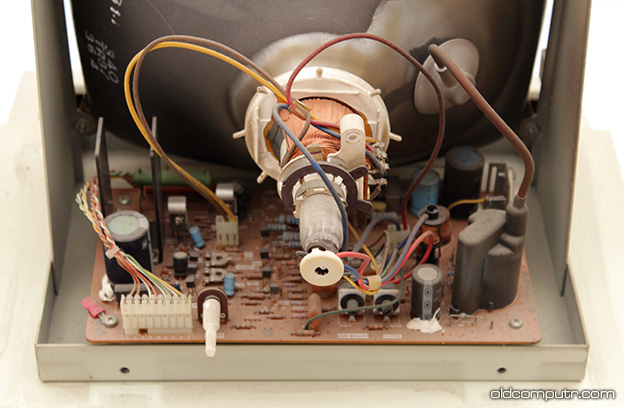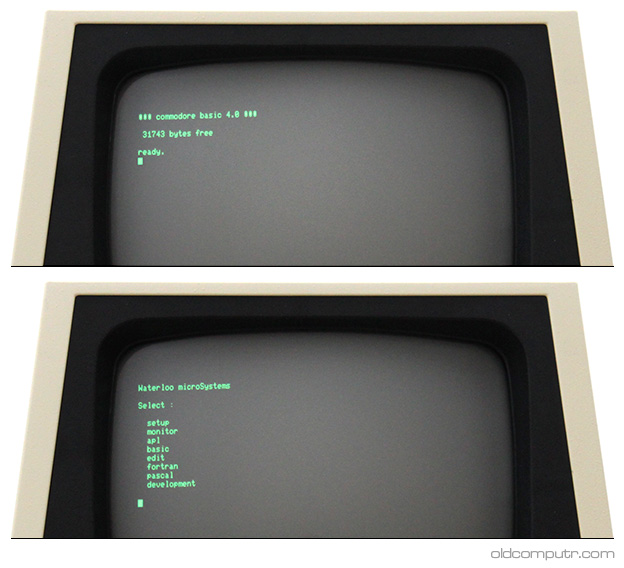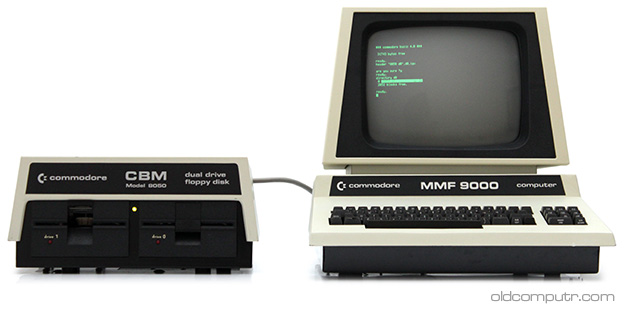
At the end of 2013 I was having dinner with a friend who owns an MMF 9000 (MMF stands for Micro MainFrame, the computer is known as SuperPET in the States), and I asked him if he could lend it to me so I could take some pictures. But by an incredible coincidence, a couple of days later I was told (thanks Marco!) about an identical computer for sale 40 Km from where I live. I called the phone number on the classified ad and on the very last day of the year I went to take a look at the computer. It worked and had all the add-on boards (two of them, it’s the first revision) that make this computer special.
I bought it for a very reasonable price and I decided to take some pictures to document this rare computer.

The computer was dirty, the inside was very dusty and most of the keys didn’t work. I took the computer apart to clean it.

After unscrewing all the screws underneath the keyboard, I was able to remove all the dirt that prevented the keys from making contact.
Removing and cleaning all the keys is a boring task, but the satisfaction of writing without having to push each key hard is worth all the time spent on the restoration.

The stickers on the keys have the symbols used in the APL language.

After separating the two halves of the computer, this is what the monitor looked like:

A detail of the monitor after cleaning it:

Now the monitor analog board is like new :-)

As I took apart and cleaned the computer, I took a shot of every piece to create the big image that I prepare for my latest posts. The original is 5184 x 31064 pixels!

This is the small board that fits in the connector of the topmost board. It contains the MOS 6702 integrated circuit, of which Commodore never released any documentation: it was used as a copy protection for the software bundled with the machine.

Here you can see the two processors, the usual 6502 and the Motorola 6809 that was used by programs and languages of the Waterloo University.

The side switches let you decide how to boot the computer: PET or… SuperPET!

After reassembling the computer I connected an 8050 floppy drive, I formatted a floppy disk and saved a program in BASIC without any errors.

Now the inside of the computer looks much better:

To close the article, one last photo of the computer and the drive.

Discover more from Oldcomputr.com
Subscribe to get the latest posts sent to your email.
You forgot to mention that VICE (vice.c64.org) emulates the SuperPET, including the copy protection chip.
Yes, you’re right, and I think you played an important role in the process of emulating the 6702.
Usually I don’t talk about emulation because I prefer the real hardware… but since it won’t last forever and many of the spare ICs are as old as the computer, sooner or later I’ll have to give up and use emulators :-)
Nah…
You won’t live long enough to have to give up and use emulators M8..
Just take a copy of all your eprom and rom chips and put them on millenium disks then if you need a spare eprom or eeprom you will always be able to find them somewhere on this planet unless ofcourse they push the button in which case it probably will not be an issue…
6502s and 6809s are still quite common.
Great post. I just received a Super PET with the dual drive and look forward to bringing it back to life.
That’s like saying to a Ferrari owner that he forgot to mention you can get a kit car and transform a Fiero, lol
You’re damn lucky to find this computer.
If/when you have to switch to a VICE emulator, do you know if it supports APL?
Hi, I never tried, but since the SuperPET and the copy protection chip are emulated in VICE, and you can find the SuperPET floppy images online, I think you can give it a try!
HI I was trying to find info on my superpet I found in my grandfather’s basement and I came across this site I have superpet up for auction on ebay it has 3 motherboards as you I don’t know much else about it I could show you photos ??
Hi Jackie, please don’t use my photos, for two reasons:
1) buyers want to see the actual conditions of what they will buy – not some pictures taken from the web;
2) someone might think that I (not you) am selling my computer, and to be honest I don’t like that…
You can put a link to this post if you want, writing “I am selling one like this” but believe me (I’m on ebay since 2001): potential buyers of a SuperPET know exactly what it is, and they want pictures of the actual item.
If you want to buy an used [insert here whatever you need], would you buy it without even seeing it?
I think he meant he could show YOU photos of the superpet he’s put on eBay
You’re right: I read “I could show YOUR photos”.
Pingback: Commodore PET and CBM | Low End Mac
Memory lane… I worked on my work terms for the University of Waterloo (Computer Systems Group) that designed SuperPet… I wrote the bank-switched linker for it
That’s awesome!
Do you know about the functionality of Waterloo BASIC on the PET 4032 and CBM 8032? I was informed by another Watcom fellow that a chip was required in the empty memory slot to enable Waterloo BASIC to run.
I have 2x PET 4032s and 3x CBM 8032s that I am trying to setup to run Waterloo BASIC.
I have got a bunch of these , some in the box new still …. Email [email protected]